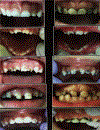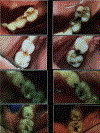Parental perceptions and acceptance of silver diamine fluoride staining
- PMID: 28457477
- PMCID: PMC6771934
- DOI: 10.1016/j.adaj.2017.03.013
Parental perceptions and acceptance of silver diamine fluoride staining
Abstract
Background: The caries arrest that can be achieved by using silver diamine fluoride (SDF) offers a minimally invasive and inexpensive alternative to traditional restorative caries treatment. The authors evaluated how the dentinal staining that is associated with SDF influences the acceptance of this treatment among parents of young children in the New York City metropolitan area.
Methods: The authors invited the parents of children who had experienced dental caries and who had appointments at the New York University Pediatric Dentistry Clinic and at several private clinics in New Jersey to participate in a Web-based survey designed to assess parents' demographics, perceptions of photographs of SDF-treated carious teeth, and acceptability of treatment in different behavior management scenarios.
Results: Ninety-eight mothers and 22 fathers from diverse backgrounds participated. Most parents (67.5%) judged SDF staining on the posterior teeth to be esthetically tolerable, but only 29.7% of parents made this same judgment about anterior teeth (P < .001). In the absence of their child having behavioral barriers to conventional restorations, 53.6% of parents reported that they were likely to choose SDF to treat their child's posterior teeth, but only 26.9% of parents were likely to choose SDF to treat their child's anterior teeth. As the number of children's behavioral barriers increased, so did the parents' level of acceptance. In extreme cases, in which parents had to decide whether their children should undergo general anesthesia during treatment, parents' acceptance rate of SDF as a treatment method increased to 68.5% on posterior teeth and to 60.3% on anterior teeth. Parents' acceptance of the treatment also varied according to their socioeconomic status.
Conclusions: Staining on posterior teeth was more acceptable than staining on anterior teeth. Although staining on anterior teeth was undesirable, most parents preferred this option to advanced behavioral techniques such as sedation or general anesthesia.
Practical implications: Clinicians need to understand parental sensitivities regarding the staining effect of SDF to plan adequately for the use of SDF as a method of caries management in pediatric patients.
Keywords: Caries arrest; dental esthetics; parental perceptions; silver diamine fluoride.
Copyright © 2017 American Dental Association. Published by Elsevier Inc. All rights reserved.
Figures











Comment in
-
Silver Diamine Fluoride Staining is Acceptable for Posterior Primary Teeth and Is Preferred Over Advanced Pharmacologic Behavior Management by Many Parents.J Evid Based Dent Pract. 2018 Mar;18(1):94-97. doi: 10.1016/j.jebdp.2018.01.001. Epub 2018 Jan 8. J Evid Based Dent Pract. 2018. PMID: 29478691
References
-
- Chu CH, Lo EC. Promoting caries arrest in children with silver diamine fluoride: a review. Oral Health Prev Dent. 2008;6(4):315–321. - PubMed
-
- Niederman R, Feres M, Ogunbodede E. Dentistry In: Debas HT, Donkor P, Gawande A, Jamison DT, Kruk ME, Mock CN, eds. Essential Surgery. Washington, DC: World Bank; 2015:173–195. Disease Control Priorities; vol. 1, 3rd ed.
-
- Mei ML, Lo EC, Chu CH. Clinical use of silver diamine fluoride in dental treatment. Compend Contin Educ Dent. 2016;37(2):93–98. - PubMed
Publication types
MeSH terms
Substances
Grants and funding
LinkOut - more resources
Full Text Sources
Other Literature Sources
Medical
Research Materials

